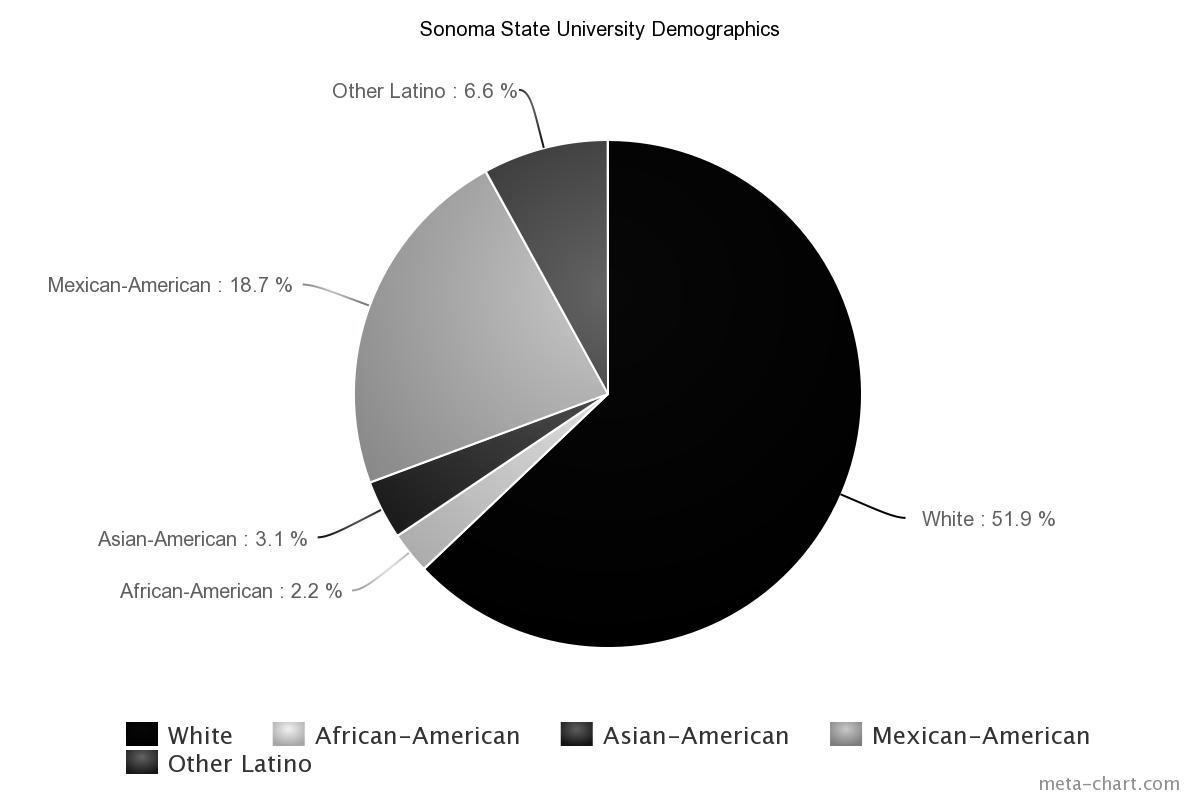The growth of Latinos in California’s higher education system has yet to translate to an increase of degrees earned for the state’s largest ethnic group.
According to data sets from calstate.edu, CSU enrollment of students who identified as Mexican-American or “other Latino” totaled 51,421 in the fall of 1994. Twenty years later, those same demographic categories totaled 159,232.
Sonoma State University experienced a similar trend, as enrollment for Mexican-American and “other Latino” totaled 583 in the fall of 1994. In the fall of 2014, enrollment was 2,335.
The University of California system also experienced a growth of individuals who identified themselves as Chicano/Latino. In 2014, this demographic enrolled at 47, 525. Ten years earlier, it was 24,646, according to universityofcalifornia.edu.
Yet, translation of increased enrollment to degrees earned is smaller than other racial groups. According to U.S. Census Bureau data from 2011-13, 12 percent of Latinos in California age 25 to 64 achieved at least a bachelor’s degree. In comparison, whites achieved the same mark at 42 percent, Asian-Americans at 53 percent and African-Americans at 23 percent.
“I think it’s up to college campuses to outreach to minority groups and ask how can universities support them better,” said Sandy Espino-Valenciano, fourth-year psychology major.
Fidel A. Vargas, president and CEO of the Hispanic Scholarship Fund, addressed a facet of this issue in a Sacramento Bee opinion piece last week. “Under-matching” is a term used when students who are well qualified to attend more selective colleges, choose not to attend.
Vargas cites a University of Southern California study in the Sacramento Bee, in which of the top 10 percent of Latino public high school graduates, nearly half choose to attend a community college, despite the fact they qualify for a four-year university.
“One of things we are doing at the Hispanic Scholarship Fund, is share information,” said Vargas. “We try to help young people understand, debunk myths or misperceptions about whether or not college is too expensive for them. In many cases it is just that, perceptions and misunderstandings which are keeping students from applying to schools they can easily be accepted to.”
Unique to the Latino experience in higher education, is the parallel growth of tuition and fee costs across the United States. From 2004-2013 alone, the average cost of tuition and fees for UC and CSU schools has increased from $4,000 to $9,000 according to Public Policy Institute of California.
“We are failing to prepare students for college. This isn’t just about providing students with scholarships or giving them tours of colleges,” said Espino-Valenciano. “[it’s about] providing students with college preparation that actually supports them in college to,” said Espino-Valenciano.
Tuition and fee cost increases, cited in a Campaign for College Opportunity 2015 study, are the reason why many Latinos opt for community college.
“When you are faced with a choice between Stanford, Berkeley, UCLA or Cal State Bakersfield and all you see is the sticker price, and you don’t understand how financial aid works, or the Pell and CAL grant system works. You might make a decision that’s not good for you and your future.,” said Vargas.
Another reason cited by the Campaign for College Opportunity study, is the unfamiliar path to-and-through college most Latinos students will take.
Latino students are left to navigate higher education by themselves since their parents are unlikely to have any experience.
Vargas said a problem exists with low graduation rates among Latinos and all minority groups because it is necessary for all who have the ability, to graduate and address what he defines as the “underutilization of incredible human capital.”
According to the Public Policy of California, it is estimated up to 2.3 million additional college educated workers will be needed by 2025.
The demand will likely fall on Latinos who have blossomed to 38 percent of the population in California at 15 million. Those figures are likely to increase as one of every two children born in the state is of Latino descent, according to the Campaign for College Opportunity study.
Educational strides for Latino are evident with examination of high school graduation rates. In 1990, 55 percent of Latinos over the age of 25 did not have a diploma. In 2013, the number dropped to 41 percent.
Of important note is a correlation between native-born or foreign-born Latinos. Older generations, primarily foreign-born, tend to have a lower percentage of college graduates and a higher percentage of no high school diplomas. Native-born Latinos are twice as likely to have college degrees and attain a high school diploma at a higher rate.
Ninety-four percent of Latinos under 18 are native born, which will likely continue the trend of higher educational attainment.





![[Both photos courtesy of sonoma.edu]
Ming-Ting Mike Lee stepped in as the new SSU president following Sakakis resignation in July 2022](https://sonomastatestar.com/wp-content/uploads/2024/04/CC4520AB-22A7-41B2-9F6F-2A2D5F76A28C-1200x1200.jpeg)



























